Restoration Part 19
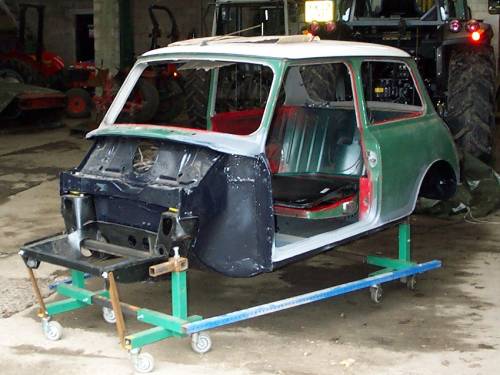
I didn't get anything done on the first 2 sessions as we were busy moving vehicles and tidying up the area we had been allocated for storing our vehicles during the year.
I spent a while getting the Mini mobile again. I mounted it on the mobile stands that I made last year. The car would need to be moved around a lot more this year as we could not leave the cars in the workshop during the week. With this in mind the legs of the stand were braced as it was a bit wobbly before. With the bracing in place the car can be manoeuvred very safely and easily by one person.
The body shell is complete, the next phase is to build the new front end. This will be a flip front made from steel. Before any work could take place it was necessary to fit doors this would allow the A panels to then be lined up and fitted ready to start the front end.
On first examination the doors looked fairly sound with a little surface rust on the bottoms and the frame. The doors were stripped of all the mechanical components (winding mechanism, locks and leavers etc) and the glass. The hinges were then removed, an impact wrench was used to remove the screws holding them to the doors as they couldn't be removed with an ordinary screwdriver. The reason they were so tight was that star locking washers had been used.
One of the hinges had a broken stud so this was drilled out and a new stud fitted and welded in place. Another of the hinges had a broken pin. This was more difficult to remove. The hinge components had to be heated up with the oxyacetylene torch and the remnants of the pin knocked out with a drift. A new pin was then fitted.
The passenger side door was then examined more closely. There was a rust patch at the bottom of the door in a central position. When this was cleaned up the rust had penetrated the door skin and the door bottom so repairs would be necessary. The rusty part was cut from the door skin this allowed access to the door frame from the inside and this received the same treatment. A patch panel was then made for the door frame and it was welded in place. My mistake was I didn't redirect the heat from the door skin and it warped and bulged out. A new door skin would look better anyway! The doorskin was carefully cut off the door frame using the angle grinder. I am actually quite glad this happened know as when the skin was off the frame I found more rust starting on the inside at the joints. This was all cleaned up.
I ordered all the parts required for the new front end together with a new door skin.
The new door skin was fitted to the frame after some careful measuring and trial fitting of the door on the car. The skin was clamped to the frame at the top and the 90% lip around the 2 sides and bottom was then carefully peaned over as far as possible. The lip was then pressed down further using a door skinning tool. The top two corners were then peaned over and welded down. The edges were then sealed with seam sealer.
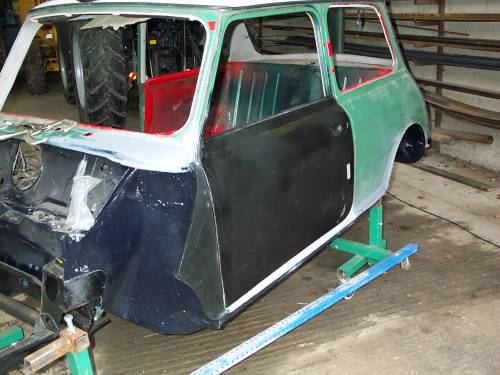
The drivers side door was not as rusty but it had suffered in the past from a few dents and there was a crease down the hinge side of the door as if it had been bent backwards to far and it had come into contact with the A panel. A new skin was ordered for this door.
The 2 doors were then fitted to the body to allow the A panels to be fitted. Washers were used on the hinges to get the best door panel gap possible.
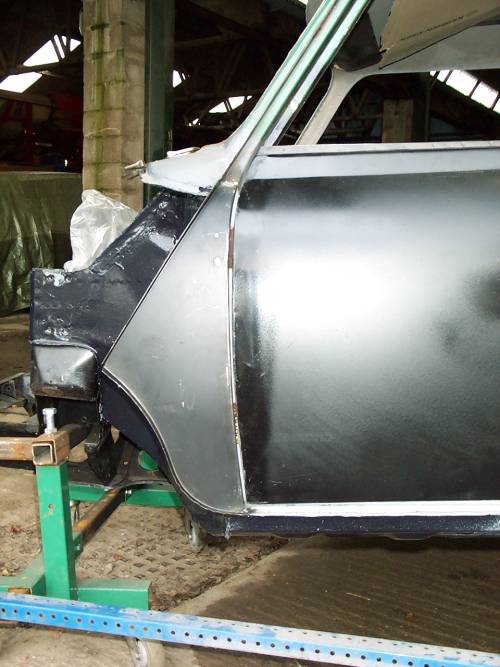
The passenger side A panel was offered up to the car. A lip was required at the bottom edge were it meats the sill to clear the step in the sill. The top edge was also trimmed a little. Kevin said it would be best to bend the 90% edge over as far a practical before fitting the panel it could then be crimped in place using the door skin crimping tool. With this done the panel was welded top and bottom with a couple of tacks down the mounting flange edge. Care was taken to ensure the door gaps remained constant. The door was then removed and the A panel flange was crimped tightly over. The drivers side panel was dealt with in the exact same way.
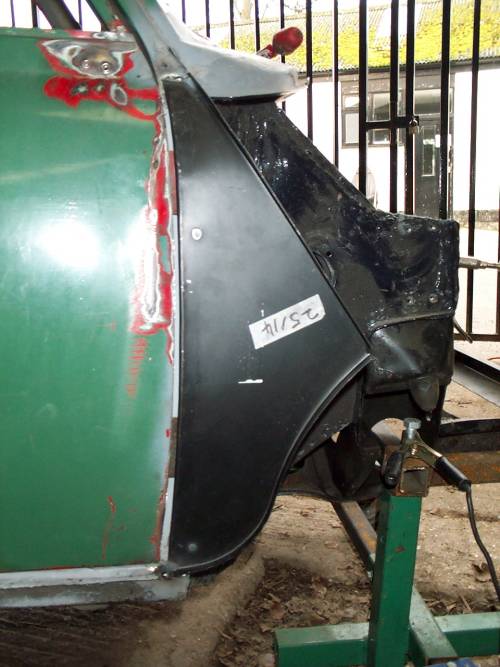
I clamped the wings in place to see if the panel contours were correct.
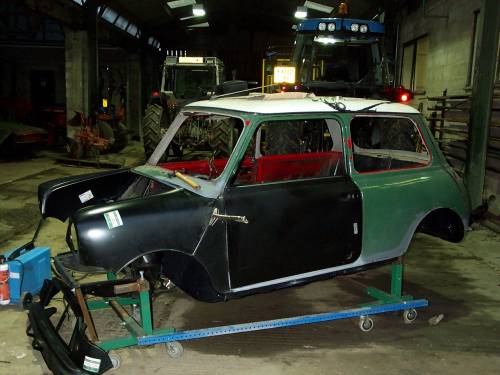
My Mini Mayfair
Restoration
- 1 - Initial Inspection
- 2 - Boot Floor 1
- 3 - Boot Floor 2
- 4 - Boot Floor 3
- 5 - Rear Valance
- 6 - Body Stands & Engine Removal
- 7 - Front End Removal
- 8 - Bulkhead 1
- 9 - Bulkhead 2
- 10 - Sills 1
- 11 - Sills 2
- 12 - Sils 3
- 13 - Sills 4
- 14 - Footwell
- 15 - Floor
- 16 - Battery Box
- 17 - Underside
- 18 - Underside protection
- 19 - A Panels
- 20 - Wings & Front Panel
- 21 - Front Panels & Arches
- 22 - Rear Subframe
- 23 - Return From Paint
- 24 - Brakes
- 25 - Wiring
- 26 - Engine 1
- 27 - Engine 2
- 28 - Fitting Engine
- 29 - Interior, Glass, Lights
- 30 - Wheels & Tyres
- 31 - Finishing Touches